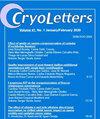稀有地方性无花果驹驹种质的微繁殖和低温保存。
IF 1
4区 生物学
Q3 BIOLOGY
引用次数: 0
摘要
背景Colchicum figlalii (Varol) Parolly and Eren的自然种群生长在安纳托利亚西南部海拔1900-2100米的狭长蛇纹岩空地上(土耳其穆格拉桑德拉斯山)。材料和方法共使用了 281 个鳞茎作为体外培养的起始材料,经过表面消毒后,从其中 157 个鳞茎中获得了干净的材料。结果在木质植物培养基(WPM)、橄榄培养基(OM)和室重与斯库格培养基(MS)上培养四周后,再生率最高(约 67.3%)。使用添加了 10.7 uM NAA 的 OM,成功地从离体生长的无花果鳞茎叶片中诱导出了胼胝体。无花果鳞茎胼胝体组织的冷冻保存采用了 PVS2-玻璃化程序。冷冻保存后,将胼胝体放入液氮前用 PVS2 处理 75 分钟,再生效果最好(66.7%)。该研究为今后长期保护难以冷冻保存的类似物种提供了有效参考。Doi.org/10.54680/fr24410110412.本文章由计算机程序翻译,如有差异,请以英文原文为准。
Micropropagation and cryopreservation of the rare endemic Colchicum figlalii germplasm.
BACKGROUND
The natural population of Colchicum figlalii (Varol) Parolly and Eren grows in a narrow area of serpentine rock clearings at an altitude of 1900-2100 m in Southwestern Anatolia (Sandras Mountain, Mugla, Turkey). The species is regarded as endangered according to the IUCN Red List Categories.
OBJECTIVE
To develop an optimum procedure for in vitro propagation and cryopreservation of germplasm of this rare endemic.
MATERIALS AND METHODS
A total of 281 bulbs were used as in vitro culture starting material and after surface sterilization, clean material was obtained from 157 of them. Woody Plant Medium (WPM), Olive Medium (OM), and Murashige and Skoog medium (MS) were used for in vitro culture establishment.
RESULTS
The maximum regeneration rate (~67.3%) was obtained after four weeks of incubation on OM. The calli were successfully induced by using OM supplemented with 10.7 uM NAA from leaves of in vitro grown C. figlalii bulbs. A PVS2-vitrification procedure was used for cryopreservation of C. figlalii callus tissue. After cryo-storage, the best result for regeneration (66.7%) was obtained from calli treated with PVS2 for 75 min before plunging into liquid nitrogen. All rooted seedlings derived from cryopreserved calli were successfully acclimatized to greenhouse conditions.
CONCLUSION
This study is an effective reference for future long-term conservation of similar species that are difficult to cryopreserve. Doi.org/10.54680/fr24410110412.
求助全文
通过发布文献求助,成功后即可免费获取论文全文。
去求助
来源期刊

Cryo letters
生物-生理学
CiteScore
1.80
自引率
10.00%
发文量
50
审稿时长
1 months
期刊介绍:
A bimonthly international journal for low temperature sciences, including cryobiology, cryopreservation or vitrification of cells and tissues, chemical and physical aspects of freezing and drying, and studies involving ecology of cold environments, and cold adaptation
The journal publishes original research reports, authoritative reviews, technical developments and commissioned book reviews of studies of the effects produced by low temperatures on a wide variety of scientific and technical processes, or those involving low temperature techniques in the investigation of physical, chemical, biological and ecological problems.
 求助内容:
求助内容: 应助结果提醒方式:
应助结果提醒方式:


